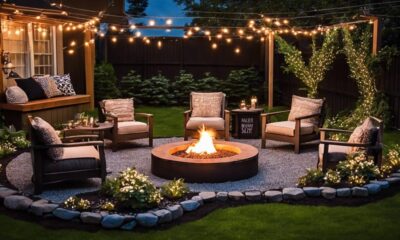Southeast Asia Decor
Why Choose Feng Shui Colors for Interiors?
You can transform your living space with Feng Shui colors, but do you know how each hue influences your home’s energy? Discover their powerful effects.

Choosing Feng Shui colors for your interiors can greatly enhance your space's energy and atmosphere. It's all about balance and harmony, which promote well-being and tranquility. Warm colors like red and orange boost creativity and social interactions, while cool colors like blue and green foster calmness and relaxation. Each color has unique properties that can transform a room's mood. By carefully selecting colors based on a room's purpose, you create a supportive environment. This thoughtful approach can elevate your everyday experience at home. Discover the impact of color on your living space for a more inviting ambiance.
Key Takeaways
- Feng Shui colors influence the energy and atmosphere of a space, promoting peace and tranquility.
- Warm colors energize environments, fostering creativity and enhancing social interactions, while cool colors promote calmness and serenity.
- Thoughtful color selection creates balance, preventing chaotic environments and enhancing overall harmony.
- Colors can improve mental clarity and well-being, supporting relaxation and productivity in designated areas.
- Aligning colors with Feng Shui principles enhances the ambiance, making spaces inviting and harmonious for occupants.
Importance of Color in Feng Shui

When it comes to Feng Shui, color really sets the tone for your space. The colors you choose influence the energy and atmosphere, helping to create environments that promote peace and tranquility.
Incorporating elements of Indonesian decorative pillows can enhance living spaces with vibrant colors and intricate patterns, further amplifying the desired energy. By understanding how different colors interact with shui elements, you can enhance the overall vibe of your home.
Warm colors like red, orange, and yellow energize your spaces, making them perfect for areas where you want social interactions and creativity to flourish, such as living rooms.
On the other hand, cool colors like blues and greens create a sense of calm and serenity, ideal for relaxation spaces like bedrooms and bathrooms.
Balancing these colors is essential; you don't want an overwhelming or chaotic environment. The purpose of each space should guide your color selection to achieve harmony.
For instance, knowing that red symbolizes luck and prosperity can help you choose the right accents to enhance your home's energy and well-being.
Effects of Warm Colors

Warm colors like red, orange, and yellow can energize your living spaces, making them perfect for areas where you want to boost social interactions.
Incorporating traditional artistry through decorative masks can complement these vibrant hues, adding depth and cultural significance to your decor.
These hues stimulate emotions and creativity, creating an inviting atmosphere that encourages connection.
Energizing Living Spaces
Incorporating warm colors like red, orange, and yellow into your living spaces can greatly boost energy and creativity. These warm colors are known for their ability to energize living spaces, making them perfect for areas where you want to foster activity and engagement.
Additionally, using these colors can reflect the natural materials and earth tones prominent in Balinese design, creating a harmonious environment. Red, the most powerful of the warm colors in Feng Shui, symbolizes luck and wealth. When used thoughtfully, it can enhance your fame and social life.
Orange adds liveliness and brightness, creating an inviting atmosphere that encourages conversation. Imagine stepping into a room awash in vibrant orange; it instantly lifts your spirits!
Yellow, representing stability and nurturing, promotes optimism and enhances creativity. It's an ideal choice for stimulating environments where you want to inspire innovative thinking.
Stimulating Social Interactions
Selecting the right colors for your interior can have a considerable impact on how people interact in your space. Warm colors like red, orange, and yellow are particularly effective for stimulating social interactions, making your living room or dining area feel more inviting.
In a traditional Indonesian style home decor, these colors can be beautifully complemented by natural materials and intricate textiles, enhancing the overall ambiance. Red, for instance, is linked to luck and prosperity in Feng Shui, creating an energetic atmosphere that encourages gathering and connection.
Orange brings a sense of enthusiasm and creativity, sparking lively conversations among your guests. When you incorporate this color, you'll likely notice an increase in engagement and interaction during your social events.
Yellow, a bright and cheerful hue, promotes optimism and clarity of thought. This can considerably enhance the overall mood, contributing to a warm environment where everyone feels comfortable and welcome.
Boosting Creativity Levels
When you want to boost creativity levels in your space, consider how colors influence your mindset. Warm colors like red, orange, and yellow are powerful tools for energizing your environment.
Red, renowned in Feng Shui, not only enhances your social life but also elevates heart rates, igniting passion that can drive your creative output. Incorporating elements such as a Face Indonesian Decor Mask can further enhance the vibrant ambiance, reflecting rich cultural heritage and intricate designs that inspire creative thoughts.
Orange exudes warmth and energy, encouraging enthusiasm and excitement—crucial elements for brainstorming sessions and innovative thinking. It creates an atmosphere where ideas can flourish freely.
Yellow, on the other hand, promotes optimism and clarity of thought, making it an ideal choice for spaces dedicated to creativity and problem-solving.
Incorporating warm colors into your interior design invites collaboration and inspires imaginative ideas. When you fill your space with these vibrant hues, you're not just decorating; you're crafting an environment that actively supports and enhances your creative endeavors.
Effects of Cool Colors

Cool colors, like blues and greens, can greatly promote calmness and serenity in your home. Incorporating elements of culture through items like Indonesian decor masks can further enhance the peaceful atmosphere.
Promoting Calmness and Serenity
Incorporating cool colors like blue and green into your interiors can greatly enhance feelings of calmness and serenity. These colors are perfect for relaxation spaces, such as bedrooms and bathrooms, where you want to unwind and recharge.
Light to mid-tone blues, associated with the wood element in Feng Shui, symbolize youth and compassion, promoting emotional tranquility. Additionally, the use of natural materials in your design, as seen in luxury tropical designs, can further amplify this serene atmosphere.
Green, also representing the wood element, is linked to growth and healing. This color fosters a sense of balance and well-being, making your living environment more inviting and peaceful.
Additionally, incorporating purples can create a serene atmosphere that supports meditation and mindfulness practices.
Using these cool colors can effectively lower stress levels and blood pressure, contributing to an overall sense of peace in your home. By choosing shades that resonate with calmness, you're not just decorating; you're creating a sanctuary that encourages relaxation and serenity.
Enhancing Relaxation Spaces
The right choice of colors can greatly enhance the relaxation spaces in your home. Cool colors, such as blues and greens, are particularly effective in promoting calmness and relaxation. When you opt for light to mid-tone blues, you're not just decorating; you're inviting youthfulness and compassion into the room, which enhances emotional well-being. This is especially beneficial in spaces like bedrooms and bathrooms, where tranquility is essential.
Additionally, incorporating elements inspired by nature, such as Indonesian wedding decor ideas, can further enrich the ambiance of relaxation areas.
Incorporating green hues into your relaxation areas symbolizes growth and healing. This connection to nature fosters a sense of balance that can elevate your overall experience in these spaces. Dark blues, corresponding to the water element, create a soothing atmosphere that supports relaxation while also encouraging knowledge and success.
Using these cool colors creates a serene environment, perfect for meditation practices. This not only helps to reduce stress but also enhances your ability to unwind completely.
Supporting Mental Clarity
Choosing the right colors for your home can greatly impact not just relaxation but also mental clarity.
Cool colors like blue and green are particularly effective in creating an environment that promotes focus and concentration. Here are three reasons to contemplate incorporating them into your spaces:
- Calmness: Cool colors are scientifically shown to reduce anxiety and lower blood pressure, helping you achieve a serene atmosphere conducive to clear thinking.
- Focus: Light to mid-tone blues encourage a positive mindset, enhancing creativity and productivity—perfect for home offices or study areas.
- Growth and Healing: Green symbolizes growth and well-being, improving concentration and making it ideal for personal development spaces.
Balancing Color in Design

Color balance in design creates a sense of harmony that makes a space inviting. When you focus on balancing color in design, you prevent overwhelming or chaotic environments. A well-thought-out color scheme considers the room's size and purpose, as well as the psychological effects colors have on your mood and energy levels.
In traditional Indonesian housing, for example, the use of specific colors can reflect cultural symbolism and regional identity, enhancing the overall aesthetic of the space traditional Indonesian housing.
Using too many warm colors can create anxiety, while excessive cool tones might make a room feel cold and unwelcoming. To achieve equilibrium, incorporate neutral colors; they provide a calming backdrop, allowing vibrant accents to shine without overpowering the overall design.
Thoughtful color combinations can enhance the elements of Feng Shui by promoting positive energy flow. When you create a cohesive palette, your space becomes more supportive of its intended functions, whether it's a cozy living room or a productive workspace.
Color Associations in Feng Shui
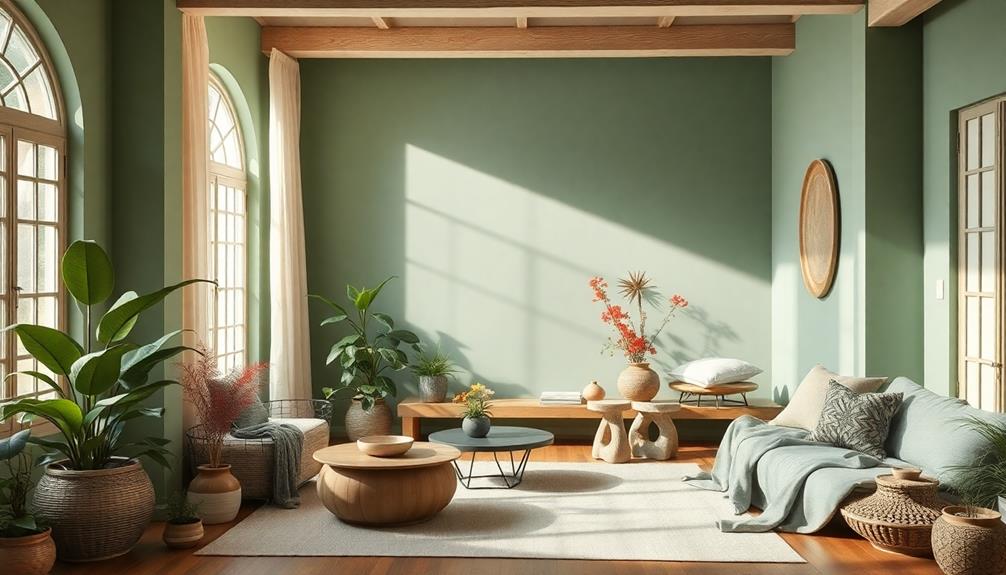
Understanding how colors influence your environment can enhance the balance you've already established in your design. In Feng Shui, color associations play an essential role in shaping the energy of your space.
The integration of natural materials and open floor plans, as seen in modern tropical aesthetics, emphasizes the importance of harmonious living spaces.
Here are three key color associations you should consider:
- White: Represents mental clarity and creativity, linked to the metal element and yang energies. It's perfect for fostering innovation in workspaces.
- Red: The most powerful color, symbolizing fire, enhances fame and social life. Use it sparingly to maintain energy balance and avoid overwhelming your space.
- Yellow: Connected to the earth element, it symbolizes stability and nurturing. This color creates warm atmospheres that support healing and emotional well-being.
Practical Color Application Tips
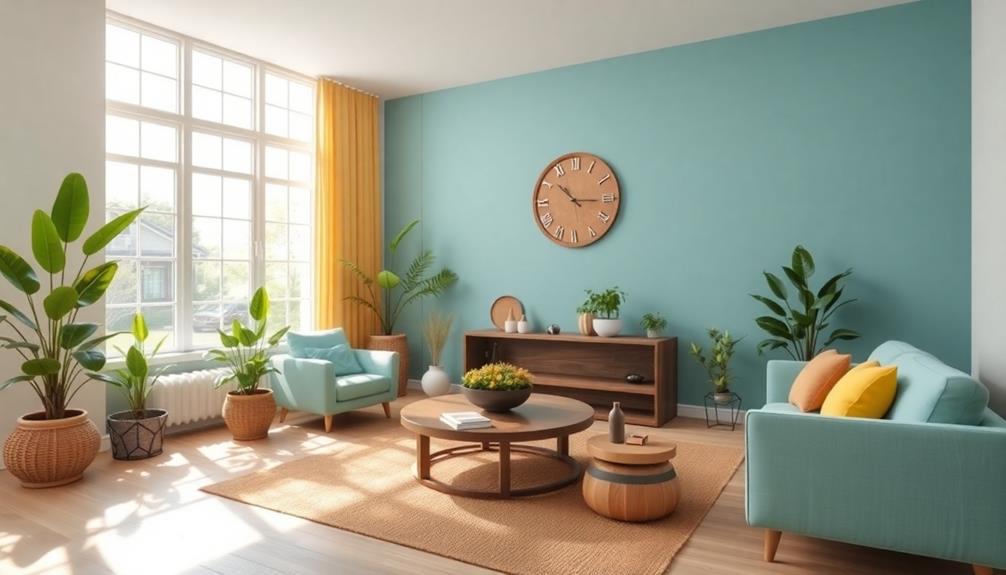
When selecting colors for your interiors, think about each room's purpose to create the desired ambiance. For bedrooms, opt for calming blues to foster tranquility and relaxation, while energetic reds can invigorate your living areas, promoting social interaction.
Testing colors in your actual space at different times of day is essential; lighting can dramatically affect how colors appear, so make certain they align with your intended atmosphere.
Balance is key—incorporate a mix of warm and cool colors to prevent sensory overload. Pair warm yellows with cool greens, as this combination nurtures a harmonious environment. Use powerful colors like red and orange sparingly. Applying these as accents rather than main wall colors helps maintain energy balance and avoids overstimulation.
Earthy tones and neutrals serve as a grounding base, promoting stability within your space. They easily complement vibrant hues in your decor, guaranteeing your interiors feel cohesive and inviting.
Enhancing Spaces With Color

Transforming your space with the right hues can markedly enhance its energy and ambiance.
By choosing colors that align with good feng shui principles, you can create a balanced and harmonious environment.
Consider these three essential tips:
1. Warm Colors: Use shades like red and yellow in active areas to stimulate social interactions and creativity.
They're perfect for living rooms where energy flows freely.
2. Cool Colors: Opt for soft blues and greens in your bedrooms or meditation spaces.
These colors foster relaxation and healing, making your environment peaceful and inviting.
3. Complementary Combinations: Pair colors thoughtfully to guarantee smooth energy flow.
For instance, combining warm and cool tones can create an inviting atmosphere that promotes well-being.
Frequently Asked Questions
What Does Feng Shui Say About Colors?
Feng Shui says colors profoundly influence your space's energy. Each color represents elements like fire or water, affecting emotions and atmosphere. Choosing colors mindfully can enhance your well-being and create harmony in your environment.
What Is the Best Color for Feng Shui House?
Think of your home as a canvas; the best color for your Feng Shui house paints harmony into your life. Choose colors based on purpose—red ignites passion, while blue invites tranquility. Balance is key!
Why Is Feng Shui Important in Interior Design?
Feng Shui's essential in interior design because it creates harmony and balance in your space. By understanding energy flow, you can enhance your well-being, relationships, and productivity, making your environment more inviting and supportive.
Which Colour Is Lucky for House Interior?
Imagine painting your living room a calming blue. You'll create tranquility and clarity, enhancing relaxation. In Feng Shui, blue's lucky for interiors, fostering peace and healing while making your home a serene retreat.
Conclusion
Choosing Feng Shui colors for your interiors isn't just about aesthetics; it's about creating a harmonious sanctuary. Each hue serves as a brushstroke on the canvas of your life, influencing energy flow and emotional well-being. By thoughtfully selecting colors that resonate with your intentions, you invite balance and positivity into your space. So, embrace the palette of your surroundings, and let these colors weave a tapestry of tranquility, transforming your home into a vibrant reflection of your inner self.
- About the Author
- Latest Posts
Introducing Ron, the home decor aficionado at ByRetreat, whose passion for creating beautiful and inviting spaces is at the heart of his work. With his deep knowledge of home decor and his innate sense of style, Ron brings a wealth of expertise and a keen eye for detail to the ByRetreat team.
Ron’s love for home decor goes beyond aesthetics; he understands that our surroundings play a significant role in our overall well-being and productivity. With this in mind, Ron is dedicated to transforming remote workspaces into havens of comfort, functionality, and beauty.
Southeast Asia Decor
Historical Feng Shui Color Schemes in Interiors
Discover how historical Feng Shui color schemes can transform your space and influence emotions, creating harmony that resonates deeply within your home.
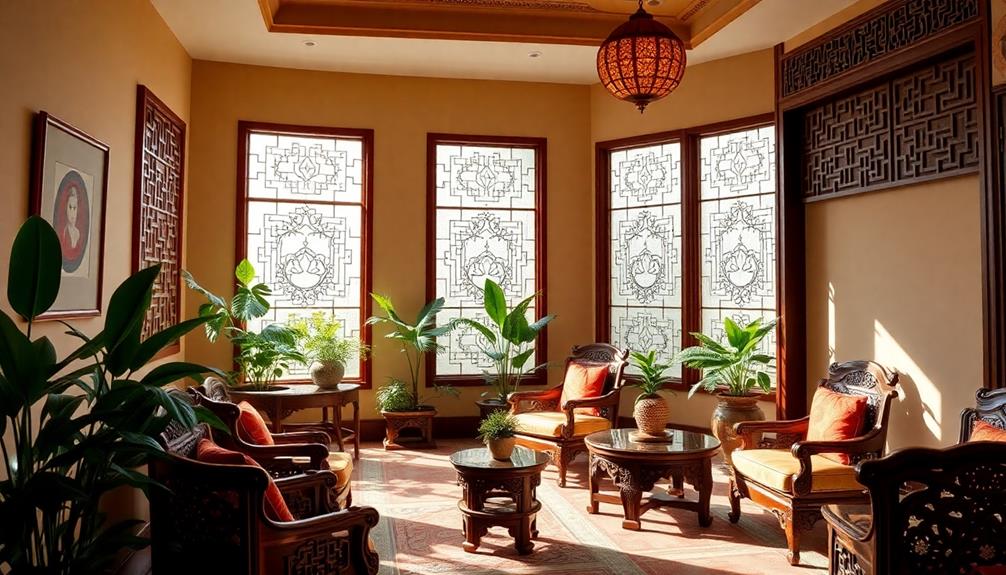
Historical Feng Shui color schemes in interiors harmonize your space by utilizing colors linked to the five elements: fire, earth, water, wood, and metal. Each color influences energy flow and emotional responses. For instance, red sparks social interaction, while soft blues promote tranquility. By aligning your color choices with the Bagua map, you can enhance specific life areas, like prosperity or relaxation. It's crucial to reflect on not just the colors but also their psychological impacts and cultural meanings. To create an inviting atmosphere, balance vibrant tones with neutrals. Discover more insights to elevate your interior design experience.
Key Takeaways
- Feng Shui color schemes are based on the five elements: fire, earth, water, wood, and metal, which influence energy flow in interiors.
- Each color corresponds to specific elements; for example, red signifies fire, ideal for enhancing social spaces and interactions.
- The Bagua map guides color choices to optimize energy in various life areas, aligning colors with directional factors for improved flow.
- Cultural context plays a vital role in color interpretation; understanding these variations enhances the effectiveness of Feng Shui in design.
- Effective color combinations, like pairing vibrant colors with neutrals, create harmony and balance while promoting desired emotional responses in living spaces.
Historical Context of Feng Shui Colors

Feng Shui colors have played an essential role in harmonizing spaces throughout history. Understanding the historical context of Feng Shui colors is significant for creating balanced interiors.
Traditionally, colors were selected based on the principles of Feng Shui, aligning with the five elements: fire, earth, water, wood, and metal. Each element corresponds to specific colors that influence energy flow in your environment. For instance, incorporating vibrant hues from Indonesian Decorative Pillows can enhance the aesthetic appeal while maintaining a harmonious atmosphere.
For instance, red, representing fire, was often used in auspicious settings to enhance fame and social interactions. On the other hand, black and dark blue, tied to water, symbolized prosperity and career success. Earth tones like yellow, brown, and orange were favored for their stability, nurturing qualities, and were commonly used in homes to promote health and well-being.
Moreover, ancient Chinese culture linked colors to astrology and personal birth charts, guiding individuals in their color choices. Feng Shui practices emphasized utilizing specific colors based on directional influences, such as red for the south and green for the east.
Elemental Color Associations

In Feng Shui, understanding the elemental color associations can transform your space.
You'll find that colors tied to the Water element, like deep blue and black, create calmness, while vibrant reds and pinks from the Fire element spark energy.
Incorporating natural materials and colors in your decor can further enhance harmony and balance within your environment.
Earth tones, such as olive green and brown, bring stability and nurturing vibes that can enhance your overall well-being.
Water Element Colors
Colors associated with the water element—shades of blue, black, and dark gray—create a calming atmosphere that promotes tranquility and depth in interior spaces. By incorporating water element colors into your design, you can enhance the flow of positive energy, or chi, in your home or office.
These colors symbolize calmness, depth, and prosperity, which are essential for creating serene environments conducive to focus and creativity. Additionally, integrating natural materials like wood and stone in your decor can further enhance the soothing effects of water element colors, promoting a balanced and harmonious interior, reminiscent of traditional Indonesian style home decor.
Using water element colors is particularly beneficial in spaces linked to knowledge, career success, and introspection. For instance, dark blues and blacks can anchor a room's energy, making them ideal for bedrooms, offices, and meditation spaces.
Light to mid-tone blues, while associated with the wood element, can still complement the water element, adding layers of depth and emotional balance.
When you choose to incorporate water element colors thoughtfully, you evoke feelings of tranquility and enhance your surroundings' overall mood. This careful selection aligns with the Feng Shui principle of balancing elemental energies, ensuring your space not only looks beautiful but also feels harmonious and nurturing.
Fire Element Colors
When you think about the Fire element in interior design, vibrant shades like red, pink, burgundy, and hot pink come to mind. These fire element colors enhance warmth, energy, and passion in your space. By incorporating them into your decor, you can stimulate social interactions and increase visibility, making them perfect for living rooms and dining areas.
| Color | Emotional Impact |
|---|---|
| Red | Power, fame, and excitement |
| Pink | Love, compassion, and warmth |
| Burgundy | Sophistication and depth |
Red is particularly powerful in Feng Shui, symbolizing fame and social life. However, it should be used sparingly to maintain energy balance. When applied strategically, these fire element colors can create a lively atmosphere, invigorating your environment.
To invoke the Fire element's properties, consider adding red pillows, vibrant artwork, or decorative candles. Each piece can spark excitement and energy in your home, encouraging a dynamic and engaging space. Embrace these fire element colors to ignite passion in your interior design!
Earth Element Colors
Embracing earth element colors can transform your space into a sanctuary of stability and nurturing energy. In Feng Shui, these colors—shades of yellow, brown, and earthy tones—promote a grounding atmosphere that enhances emotional balance and self-love. Incorporating unique decor elements, like a Face Indonesian Decor Mask, can further enhance the grounding effect of these colors by adding cultural significance and depth to your interior.
Using yellow in communal areas like living rooms or studios can uplift your spirit and spark creativity, creating an inviting environment for everyone. Meanwhile, brown tones evoke a sense of stability and support, making them perfect for relaxation spaces such as bedrooms and study areas.
By incorporating a harmonious blend of yellows and browns, you can cultivate a warm atmosphere that fosters healing and well-being. These earth element colors aren't just about aesthetics; they play a crucial role in enhancing relationships and promoting a nurturing environment.
When you carefully select and combine these hues, you create a backdrop that encourages connection and tranquility. So, consider how you can integrate earth element colors into your home.
Whether it's through paint, decor, or accessories, you'll find that these colors can meaningfully enrich your living experience, grounding you in comfort and stability.
Psychological Impact of Color Choices

Understanding the psychological impact of color choices can transform your interior spaces into havens of well-being. Color choices considerably influence your mood and emotions. For instance, warm colors like red and orange can boost your energy levels and excitement, while cool tones such as blue and green foster calmness and tranquility.
Additionally, the choice of colors in traditional Indonesian housing often reflects cultural symbolism and social status, which can also be considered when designing interiors traditional Indonesian housing. If you want to enhance focus and productivity, consider incorporating blue hues in your workspaces.
It's essential to recognize that the psychological effects of color vary across cultures. While white often symbolizes purity in Western societies, it may represent mourning in some Eastern traditions. This cultural context is crucial when making your color choices.
Mindfully selecting colors can greatly enhance your overall well-being. Balanced color schemes reduce stress levels and promote positive mental health, making your environment more inviting.
Using neutral colors as a backdrop can create a calming effect, allowing you to introduce bolder accent colors that stimulate creativity without overwhelming your space. By understanding and applying these principles, you can create interiors that not only look beautiful but also nurture your mental and emotional state.
Practical Applications in Interior Design

Color choices can be directly applied in interior design to enhance both aesthetics and energy flow. By understanding historical Feng Shui color schemes, you can create spaces that not only look good but also promote good feng shui.
For example, incorporating local craftsmanship can elevate the overall design, as seen in the sustainable craftsmanship in Balinese furniture. Here are some practical applications in interior design to contemplate:
- Purpose-Driven Colors: Use greens and blues in a study to enhance knowledge, while reds and oranges can energize social spaces, fostering interaction.
- Elemental Harmony: Incorporate colors from the Five Elements Theory—like blues for water or yellows for earth—to balance the room's energy and reflect its purpose.
- Light vs. Dark: Choose lighter colors to promote clarity and creativity in working areas, while darker shades can create a calming atmosphere in bedrooms or meditation spaces.
- Complementary Combinations: Pair earth tones with vibrant hues to achieve stability and dynamism, creating a balanced atmosphere that supports well-being.
Color Combinations for Energy Balance
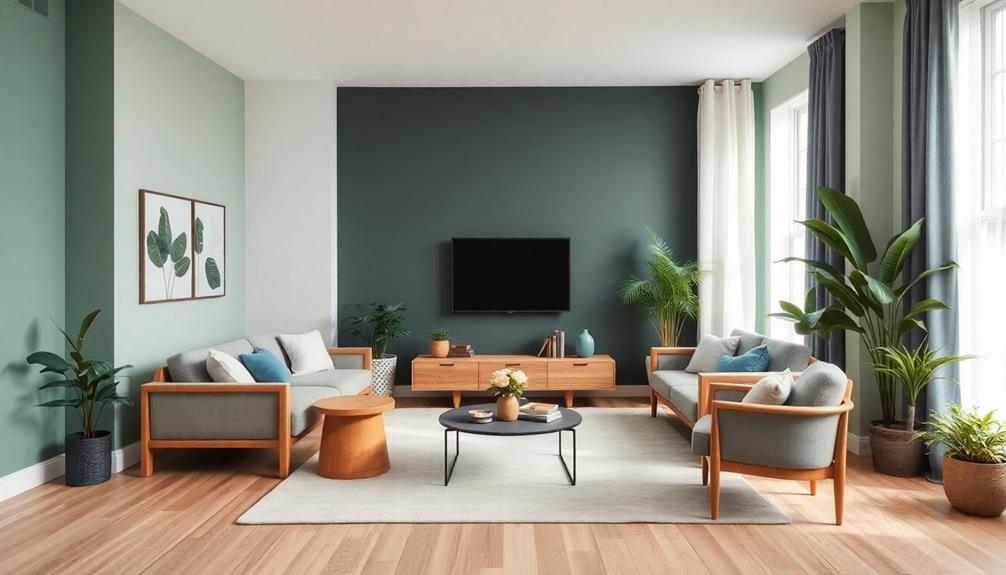
Achieving energy balance in your space hinges on the right color combinations. In Feng Shui, selecting hues that harmonize rather than clash is essential for maintaining a smooth energy flow. For instance, complementary color pairings like blue and orange or green and red can enhance energy dynamics, adding visual interest while keeping equilibrium.
Incorporating elements of traditional artistry, like Indonesian decor masks, can also deepen the connection between color and culture, enriching the overall ambiance of your space.
Don't forget to incorporate neutral colors like beige, gray, and taupe as your backdrop. These shades stabilize the room's energy, allowing more vibrant colors to shine without overwhelming the environment. Using the Five Elements theory can also guide your choices; for example, pairing fire colors like red or pink with earth tones such as yellow or brown promotes health and liveliness.
Consider the psychological effects of your color combinations too. Light blues evoke calmness and serenity, making them perfect for bedrooms or relaxation areas, while warm yellows can stimulate optimism and creativity, ideal for kitchens and communal spaces.
Common Mistakes in Color Selection
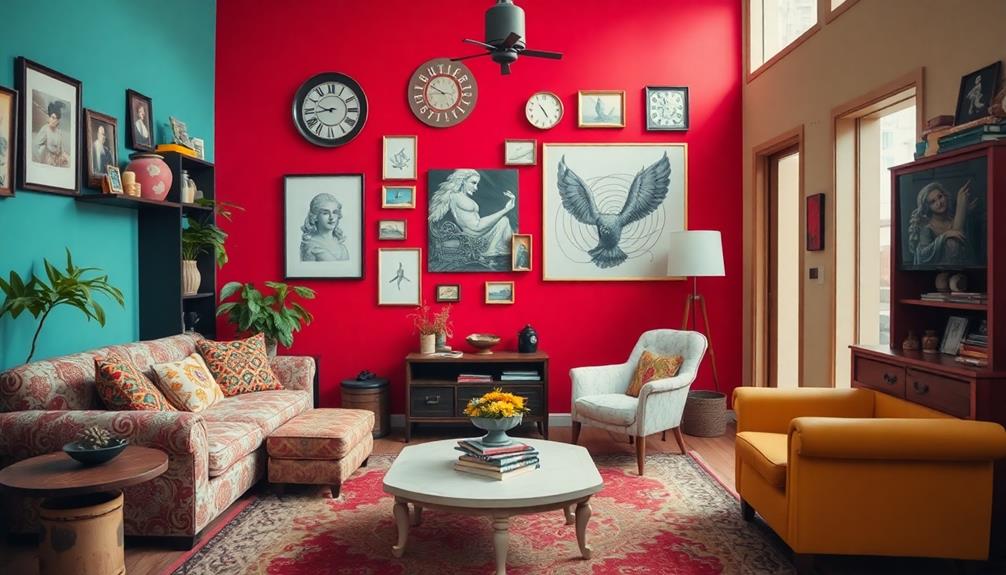
When selecting colors for your space, you might accidentally choose hues that don't align with the room's energy, leading to ineffective Feng Shui.
Incorporating cultural elements, such as Indonesian decor masks, can enhance the ambiance and connection to the chosen colors.
You could also misinterpret the directional elements, opting for colors without considering their elemental properties.
Misaligned Color Choices
Misaligned color choices can disrupt the harmonious flow of energy in your space, leading to unintended consequences. When selecting colors, it's vital to avoid common pitfalls that can negatively impact your environment. Here are four mistakes to watch out for:
1. Ignoring Room Energy: Choosing colors based solely on your personal Gua or Trigram without considering the room's specific energy can create a mismatch, resulting in negative energy flow.
For example, in event design, selecting colors influenced by Indonesian culture can enhance the ambiance and support the intended atmosphere.
2. Misinterpreting Directional Elements: Using colors like red for the south without aligning them with the room's intended purpose can lead to misaligned color choices that don't support your goals.
3. Rigid Adherence to Arbitrary Assignments: Following the Black Hat School's Bagua Map too strictly can divert you from traditional Feng Shui principles, leading to ineffective color schemes.
4. Overlooking Individual Sensitivity: Neglecting your own color sensitivities and how colors affect mood can create stagnation or discomfort in your space.
Directional Element Misinterpretation
Directional element misinterpretation can seriously skew your color selection process, leading to a mismatch between your intended energy and the actual vibe of the space. When you misinterpret directional elements, you might choose colors incorrectly, like opting for red in the south without considering the specific energy context of that room.
It's common for practitioners to focus solely on personal Gua or Trigram, neglecting the broader implications that directional elements have on room energies. Additionally, like in tropical villa plans, where natural light and open spaces play a vital role, the right color choices can enhance that uplifting atmosphere.
The Black Hat School's Bagua Map often assigns arbitrary colors that diverge from traditional feng shui principles, resulting in misapplication during color selection. In addition, New Age interpretations can distort the Lo-shu grid, impacting your understanding of color associations with directional elements.
Rigidly adhering to function-based color assignments without considering color sensitivity can disrupt the intended energy flow in your space.
To avoid these pitfalls, take time to understand the nuanced relationships between colors and their corresponding directional energies. By doing so, you'll guarantee that your color choices genuinely enhance the ambiance you want to create, promoting harmony and balance in your environment.
Overemphasis on Personal Preference
Overemphasizing personal preference in color selection can lead to significant mistakes in creating an effective Feng Shui environment.
While it's natural to want to choose colors you love, doing so without considering their energy implications can backfire.
Here are four common pitfalls to avoid:
- Ignoring Room Purpose: Choosing colors solely based on your Gua or Trigram mightn't align with the room's intended energy, disrupting its purpose.
- Directional Misalignment: Misinterpreting directional elements can result in selecting colors that clash with the desired energy flow. For instance, using red for the south without considering broader impacts can be detrimental.
- Neglecting Energy Balance: A rigid adherence to personal preferences can overlook the essential balance of energies. This can create disharmony, counteracting the benefits of Feng Shui.
- Aesthetic Over Function: Focusing purely on how a color looks, rather than its elemental associations, can undermine your space's overall harmony and well-being.
Guidelines for Choosing Colors

Choosing the right colors for your interiors can profoundly influence the atmosphere of your space. Start by considering the corresponding element each color represents. For instance, red symbolizes fire, enhancing energy and passion, while blue represents water, promoting calmness and career success.
Utilize the Bagua map to identify which areas of your space you want to enhance. Specific colors can boost aspects of life; green fosters family connections, while gray supports career aspirations.
It's crucial to balance vibrant colors, like red and orange, with softer neutrals or earth tones to avoid overstimulation and maintain harmony.
Incorporate color combinations that follow the creative cycle of elements. For example, pairing wood tones (green and brown) with fire colors (red and pink) can enhance prosperity and warmth in your space.
Lastly, pay attention to the orientation of your room. North-facing spaces benefit from cool colors like blue and gray, while south-facing areas thrive with warm tones such as red and orange.
Cultural Variations in Color Meaning

Colors carry diverse meanings across cultures, shaping how we perceive and use them in interior design. Understanding these cultural variations in color meaning is essential, especially when applying principles of Feng Shui. You might choose a color with a specific intention, but its interpretation can vary dramatically based on cultural context.
Consider these examples:
- White: In Western cultures, it symbolizes purity and new beginnings, while in some Asian cultures, it's a color of mourning and death.
- Red: In many African cultures, it signifies danger or sacrifice, but in Latin America, it represents joy and celebration.
- Green: Often linked to fertility and prosperity in the West, it's associated with paradise and spirituality in some Middle Eastern cultures.
- Blue: Seen as calming in Western societies, but it may evoke sadness or mourning in other cultures.
Being mindful of these variations can considerably affect your interior design choices. A color you find auspicious in Feng Shui mightn't convey the same message in other cultures, impacting the overall ambiance of your space.
Transformative Design Strategies
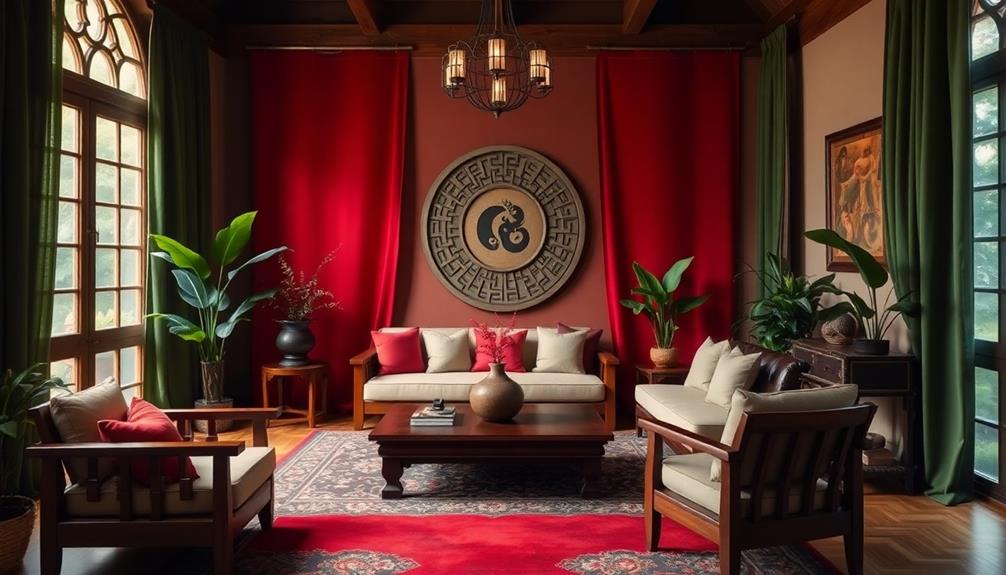
Transformative design strategies in Feng Shui can truly elevate your interior space, helping to create an environment that supports your well-being. By optimizing furniture arrangement, you enhance the energy of a room, ensuring pathways are clear for smooth movement. Incorporating natural elements like plants and water features fosters tranquility and a deeper connection to nature.
Consider how color schemes aligned with the five elements can influence emotions and energies. Warm colors can ignite passion, while cool tones promote relaxation. An open layout encourages interaction and community, while defined zones can enhance focus and productivity.
Here's a quick reference to visualize the impact of these strategies:
| Element | Effect on Energy of a Room |
|---|---|
| Wood | Growth and liveliness |
| Fire | Passion and warmth |
| Earth | Stability and nourishment |
| Metal | Clarity and precision |
| Water | Calmness and reflection |
Frequently Asked Questions
What Colors Should Be Avoided in Feng Shui?
In Feng Shui, you should avoid black in bedrooms and kitchens, as it creates stagnant energy. Also, steer clear of bright clashing colors and excessive browns, which can disrupt harmony and lead to negative feelings.
What Are the Feng Shui Interior Colors?
You'll find that Feng Shui interior colors can transform your space. Red ignites energy, while earth tones ground you. Deep blues bring calm, greens promote growth, and metallics spark creativity—a harmonious blend enhances your environment beautifully.
What Is the Feng Shui Color Theory?
Feng Shui color theory connects colors to five elements—Fire, Earth, Water, Wood, and Metal. You can enhance energy flow and emotional balance by choosing colors that resonate with these elements in your space.
What Is the Color of Fame in Feng Shui?
In Feng Shui, the color of fame is red. It symbolizes energy and passion, enhancing visibility and recognition. By incorporating red elements in your space, you can boost your reputation and social presence effectively.
Conclusion
In summary, mastering the magical marriage of colors can transform your space into a serene sanctuary. By understanding historical hues and their harmonious healing properties, you'll create an enchanting environment that resonates with energy and elegance. Avoid common color conundrums by following thoughtful guidelines, and embrace the rich cultural canvas of color meanings. So, immerse yourself in the delightful world of design and let your interiors flourish with feng shui finesse!
- About the Author
- Latest Posts
Introducing Ron, the home decor aficionado at ByRetreat, whose passion for creating beautiful and inviting spaces is at the heart of his work. With his deep knowledge of home decor and his innate sense of style, Ron brings a wealth of expertise and a keen eye for detail to the ByRetreat team.
Ron’s love for home decor goes beyond aesthetics; he understands that our surroundings play a significant role in our overall well-being and productivity. With this in mind, Ron is dedicated to transforming remote workspaces into havens of comfort, functionality, and beauty.
Southeast Asia Decor
Feng Shui Color Palettes for Your Home
Craft your home’s energy with Feng Shui color palettes, but which hues will truly transform your space into a harmonious sanctuary? Discover the secrets inside.
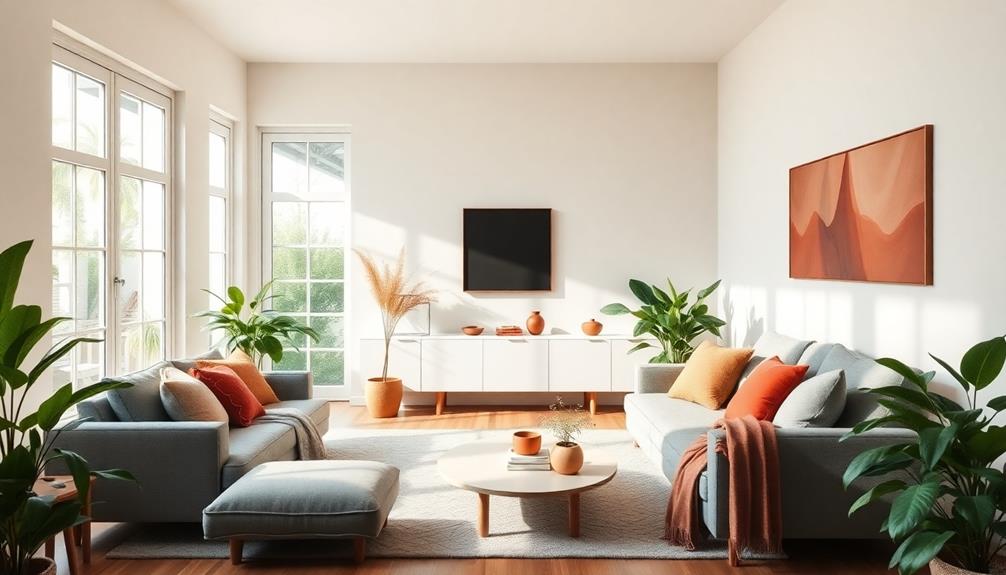
Feng Shui color palettes can truly elevate your home's energy by promoting balance and harmony. Choose colors based on the five elements: calming blues and blacks for serenity, vibrant greens for growth, and warm reds or yellows to stimulate creativity. Mixing warm and cool shades can create the perfect atmosphere in each room—invigorating for your living spaces and soothing in bedrooms. Consider room-specific recommendations, like soft tones for the bathroom or lively hues for social areas. By understanding how color influences energy, you can transform your environment. Explore further to discover how to optimize your home's color scheme.
Key Takeaways
- Choose colors based on feng shui elements: blue and black for water, green for wood, red for fire, yellow for earth, and white for metal.
- Balance warm and cool colors to enhance positive energy, avoiding excessive warmth that can cause anxiety or too much coolness that feels unwelcoming.
- Utilize the Bagua Map to identify areas in your home that benefit from specific colors to promote harmony and connection.
- Incorporate soft, warm tones in bathrooms and earthy hues in living spaces for a calming atmosphere and to enhance family ties.
- Align color choices with personal goals and emotional needs to create a nurturing and uplifting environment in your home.
Understanding Feng Shui Principles
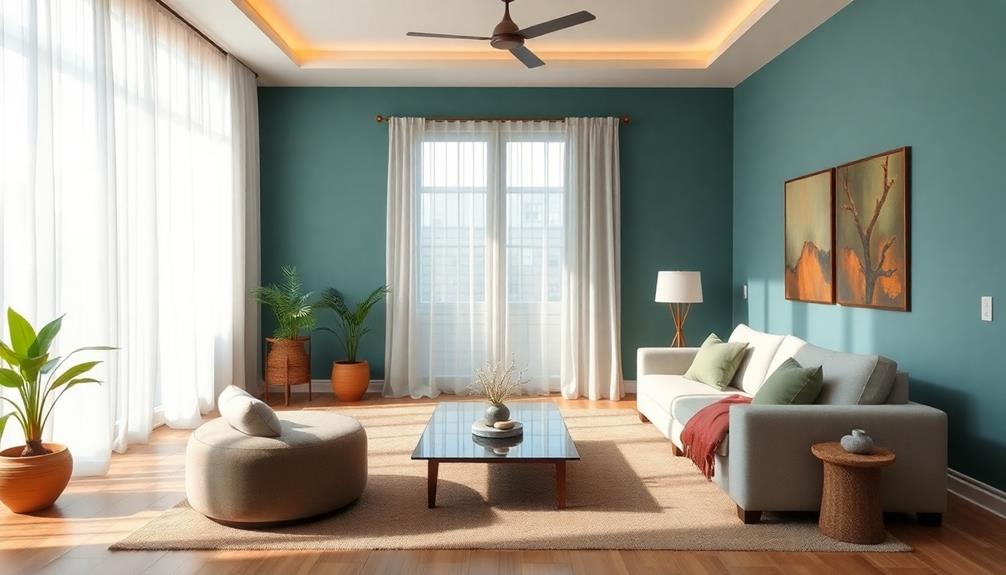
Feng shui revolves around the strategic placement of objects and colors to enhance the flow of positive energy, or chi, in your space. To effectively harness this energy, you need to understand the principles behind Feng Shui colors. Each color corresponds to one of the five elements—water, wood, fire, earth, and metal—allowing you to create a harmonious environment tailored to your needs.
Incorporating elements of traditional Indonesian style home decor can further enhance this balance, as natural materials and intricate designs promote a sense of tranquility and connection to nature.
Your color choice can markedly affect the mood and functionality of a room. For instance, warm colors like red and orange can invigorate a space, stimulating passion and creativity.
On the other hand, cool colors like blue and green promote calmness but can also lead to a chilly atmosphere if overused. Balancing these colors is essential; too much fire energy can lead to anxiety, while excessive blue can make a room feel unwelcoming.
Color Associations and Their Effects

Colors play a significant role in shaping the atmosphere of your home, each carrying unique associations and effects that influence your well-being. In Feng Shui, colors are linked to specific energies and can have profound impacts on your emotions and daily life.
For instance, blue and black represent the water element, promoting calmness and enhancing concentration. These colors are perfect for creating restful spaces like bedrooms and bathrooms, where you want to unwind. Incorporating elements of Indonesian decorative pillows with vibrant colors can further enhance the soothing ambiance.
Green, associated with the wood element, symbolizes growth and renewal, motivating change and strengthening family ties.
If you're looking to invigorate a space, red is your go-to color. This fire element hue increases heart rate and stimulates passion, making it ideal for lively areas like living rooms.
On the other hand, yellow represents the earth element and infuses hope and clarity, creating nurturing environments that support creativity and healing.
Lastly, white and metallic shades symbolize purity and mental clarity, making them beneficial in workspaces where focus is essential.
Element-Based Color Selection
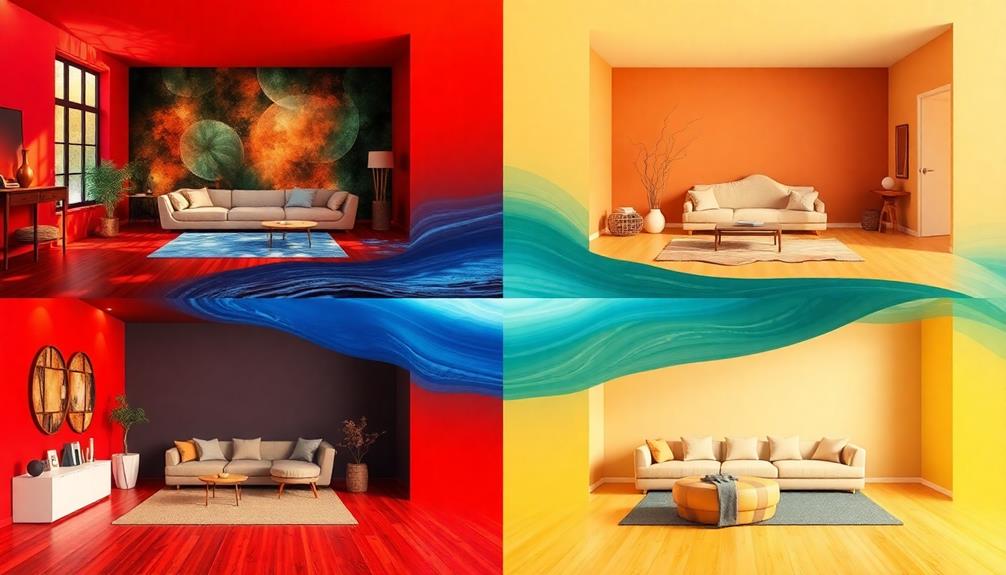
When selecting colors for your space, it's crucial to understand how each feng shui element influences energy.
Incorporating unique decorative pieces like Indonesian decor masks can also enhance the atmosphere by adding cultural significance and vibrant artistry.
You can enhance the atmosphere by pairing specific colors with their corresponding elements, creating a balanced and harmonious environment.
Let's explore the characteristics of each element and discover effective color pairing strategies to elevate your home or office.
Element Characteristics Overview
Understanding the characteristics of each elemental color can greatly enhance your space's energy and atmosphere. When you incorporate the right colors based on element characteristics, you'll create good feng shui that promotes balance and harmony in your home.
In many cultures, including those reflected in traditional Indonesian housing, the integration of natural elements into design is essential for creating harmonious living spaces.
The Water Element, represented by calming blues and blacks, fosters tranquility and concentration, making it ideal for study areas.
The Wood Element, with its vibrant greens, symbolizes growth and liveliness, enhancing family ties and motivating positive change.
If you seek energy and passion, the Fire Element brings vibrant reds and oranges into your space, stimulating social interactions and creativity.
For a sense of stability and nurturing, turn to the Earth Element, which encompasses warm yellows and browns, creating a grounding atmosphere.
Color Pairing Strategies
Incorporating element-based color selection enhances the energy of your space by aligning colors with the five feng shui elements. For effective color pairing strategies, consider how colors interact with the wood element and fire energy.
For instance, pairing warm hues like red with yellow can invigorate active spaces, making them lively and welcoming. This combination is perfect for rooms where you entertain, such as living rooms. Additionally, incorporating unique decor pieces, like an Indonesian Decor Mask, can further enrich your space by representing cultural stories and craftsmanship.
On the other hand, soft greens combined with muted yellows can create a tranquil atmosphere, promoting well-being and harmony. This pairing draws from the wood element's calming qualities while balancing the grounding nature of earth tones.
Utilizing the bagua map will help identify which areas of your home can benefit from specific colors. For instance, you could use turquoise to blend the wood and water elements, fostering growth and adaptability.
Always think about how the colors you choose will affect the overall energy in each room, ensuring that your selections align with both your intentions and the natural balance of feng shui.
Room-Specific Color Recommendations

When choosing colors for your bathroom, soft warm tones paired with white or pale hues can help balance the strong water energy.
Incorporating natural materials and earth tones can further enhance a calming atmosphere, creating a serene retreat reminiscent of Balinese design concepts.
In your living room, aim for a mix of vibrant and calming colors to create a harmonious atmosphere that encourages both energy and relaxation.
Let's explore how these color choices can enhance the energy in your spaces.
Bathroom Color Considerations
Choosing the right colors for your bathroom is essential for creating a harmonious space that promotes relaxation and balance. In feng shui, bathrooms are linked with the water element, which can lead to an imbalance if not properly managed. Soft whites, grays, and pale blues or greens stabilize the water element's energy. Incorporating warm accents like soft peach or beige helps balance the coolness of blue tones, fostering auspicious yin energy.
To ground the energy and prevent feelings of overwhelm, consider using earthy tones. Here's a quick reference guide to help you choose the best colors for your bathroom:
| Element | Recommended Colors | Purpose |
|---|---|---|
| Water Element | Soft blues, pale greens | Stabilizes water energy |
| Earth Element | Beige, soft peach | Balances coldness and promotes warmth |
| Neutral Tones | Soft whites, light grays | Creates a clean, serene atmosphere |
| Clutter-Free | Organize and declutter | Enhances positive energy flow |
Living Room Color Balance
After creating a balanced atmosphere in your bathroom, it's time to focus on the living room, where color plays an essential role in fostering a welcoming environment.
A well-decorated living space can also incorporate elements like Indonesian wedding decor ideas to enhance the warmth and richness of the room. Here, you'll want to incorporate colors that promote both energy and relaxation.
A balanced mix of warm colors like red and yellow can energize the space, while cooler tones like blue and green encourage a tranquil atmosphere.
To create a harmonious living room, consider these color recommendations:
- Use warm neutrals alongside soft, muted colors for tranquility.
- Incorporate shades from the Zhen, Dui, and Xun areas of the bagua map to enhance family connections.
- Add vibrant colors as accents, but balance them with calming hues.
- Guarantee a good mix of yin (cool) and yang (warm) energies.
- Use color strategically to reflect the gathering purpose of the space.
Balancing Warm and Cool Colors
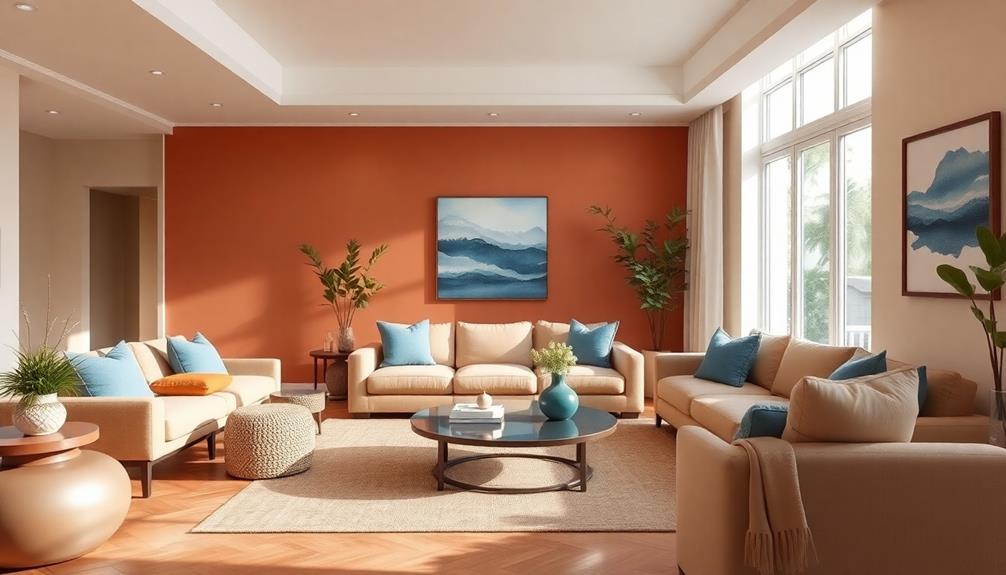
Balancing warm and cool colors is essential for creating a harmonious atmosphere in your space. Too many warm colors, like red and yellow, can lead to feelings of anxiety, while an excess of cool colors, such as blue and green, may make a room feel cold and uninviting.
It's important to find that balance to promote positive energy. Utilizing insights from expert tropical design can also guide your color choices in achieving a serene environment.
In active areas like your living room or kitchen, incorporate warm colors to stimulate social interactions. For more tranquil spaces, such as bedrooms and bathrooms, cool colors can create a calming environment.
Use the five feng shui elements—water, wood, fire, earth, and metal—as a guide to guarantee each room's energy aligns with its purpose.
Thoughtful combinations can enhance energy flow; try mixing warm neutrals with soft blues or greens for a balanced feel. A color wheel can also be a helpful tool for selecting complementary warm and cool colors.
Personal Preferences in Color Choice

When you choose colors for your space, think about how they make you feel emotionally.
For instance, incorporating elements like Indonesian decor masks can't only enhance the aesthetic appeal but also infuse your home with rich cultural heritage.
These personal connections can greatly influence the energy in your home, helping to create an environment that supports your goals.
Emotional Connection to Colors
Often, personal color preferences play a crucial role in how you feel within your living space. The colors you choose can greatly influence your mood and emotional well-being.
For instance, incorporating natural materials and hues inspired by modern tropical aesthetics in Bali can enhance your connection to nature, fostering a serene environment.
Colors evoke emotional responses, so selecting hues that resonate with you is essential for enhancing positive chi.
Consider these aspects of your personal color preferences:
- Warm colors like red and orange can energize and inspire passion.
- Cool colors such as blue and green promote relaxation and calmness.
- Neutral tones offer balance, providing a soothing backdrop for your favorite accents.
- Bold shades can create excitement, making spaces feel dynamic.
- Soft pastels may evoke tranquility, perfect for restful areas.
Impact on Space Energy
The energy of a space is profoundly shaped by your personal color choices, as these hues can either uplift or drain the atmosphere. When you select colors that resonate with you, you promote positive chi and create an environment filled with happiness and comfort.
Conversely, a color you dislike can negate that positive energy, making it essential to choose hues that you genuinely enjoy.
The psychological impact of color varies widely. Warm colors like red and orange can energize a space, while cool colors such as blue and green often create a calming atmosphere. Your personal taste plays a big role in this dynamic.
Additionally, incorporating your favorite colors into your decor fosters emotional connections to your space, enhancing the overall energy.
Feng Shui principles highlight the importance of aligning color schemes with the intended function of each room. This alignment not only boosts space energy but also enhances the effectiveness of your design choices.
Personal Goal Alignment
Aligning your color choices with personal goals can create a powerful synergy in your space, enhancing both your environment and your aspirations.
When you select colors that resonate with your personal preferences, you're not just decorating; you're cultivating an atmosphere that supports positive chi and fuels your ambitions.
To get started, consider these points when choosing your color palette:
- Identify Your Goals: What do you want to achieve? Choose colors that inspire those aspirations.
- Reflect on Emotions: Select hues that evoke feelings of comfort and happiness, aligning with your emotional needs.
- Experiment with Shades: Explore different shades; often, subtle variations can have distinct effects on energy flow.
- Create Balance: Mix colors that promote both creativity and tranquility to foster a harmonious atmosphere.
- Prioritize Enjoyment: Remember, the colors you love will directly contribute to a more uplifting environment.
When you personalize your color palette, you not only express your unique identity but also cultivate a space that inspires creativity, motivation, and a sense of peace.
Embrace the colors that work for you!
Key Color Recommendations for Spaces

Creating a harmonious environment is essential for enhancing the energy in your living spaces, and choosing the right colors plays a crucial role. For a calming backdrop, warm neutrals like greige and taupe are perfect. They promote tranquility and help you feel at ease.
In bedrooms and bathrooms, opt for soft greens and blues; these colors provide a natural balance and encourage relaxation, much like the soothing qualities of water.
If you want to add some vibrancy, consider incorporating yellow. This color introduces a touch of yang energy, making it ideal for kitchens and living rooms, where creativity and warmth are key.
Meanwhile, rich grays can balance out strong metal fixtures, creating a sophisticated and stable atmosphere in dining or working areas.
For spaces that feel too stark or rigid, muted yellows and golds can warm up cold color palettes. These colors enhance the energy in your environment while maintaining a sense of comfort.
Seasonal Color Considerations

As the seasons change, adjusting your color palette can greatly enhance the energy flow in your home.
By aligning with nature's rhythms, you create harmony that supports your mental and emotional well-being.
Here's how to incorporate seasonal color palettes effectively:
- Spring: Use soft pastels like light greens and yellows to symbolize renewal and growth. These colors invite fresh energy.
- Summer: Bright blues and reds energize your spaces, perfect for gatherings and socializing, maximizing water energy.
- Autumn: Warm oranges, browns, and deep reds create a cozy atmosphere, reflecting the harvest season and fostering gratitude.
- Winter: Cool blues and whites evoke tranquility and calmness, ideal for restful spaces during colder months.
- Transitional Colors: Consider hues that blend seasons, like shifting from vibrant summer colors to warm autumn tones.
Practical Home Decor Tips

Seasonal color adjustments can greatly influence your home's ambiance, but practical decor tips take your space to the next level. To enhance your interior design, consider incorporating colors that align with the elements of Feng Shui. For example, warm reds and energizing oranges can stimulate creativity in your home office. When you match paint colors with existing decor elements, you create a cohesive look that enhances energy flow.
Here's a quick guide to help you choose colors effectively:
| Area | Recommended Color | Purpose |
|---|---|---|
| Home Office | Warm Reds/Oranges | Stimulates creativity |
| Conversation Area | Salmon | Enhances emotional connection |
| Kitchen | Light Greens | Promotes harmony |
| Living Room | Soft Earth Tones | Creates relaxation |
Also, when considering home repairs, weigh your skill level against the complexity of the task. Using the right materials, like durable tiles, can make a significant difference in your home's longevity. Remember, thoughtful color combinations not only beautify your space but also improve its energy. Use a color wisely to uplift your home!
Resources for Further Exploration

To truly enhance your understanding of Feng Shui color palettes, immerse yourself in a variety of resources that can provide valuable insights. Here are some key resources to explore:
- Bagua Map: Understand how different areas of your home correspond to specific Feng Shui elements and color recommendations.
- Color Wheels: Utilize these to visualize effective color combinations that enhance the desired energy in each room.
- Online Tools: Investigate resources that simulate various color palettes and lighting conditions to aid in your color selection process.
- Feng Shui Literature: Read books and guides that examine how colors influence mood and energy flow within your living spaces.
- Community Engagement: Join online communities or workshops focused on Feng Shui to share experiences and gain insights into practical applications of color palettes in home decor.
Frequently Asked Questions
What Is the Best Color for a House in Feng Shui?
Choosing the best color for your house depends on its purpose. For calming spaces, go with blues or greens. In active areas, opt for warm colors like red or orange to boost energy and social interaction.
How Do I Choose the Right Color Scheme for My House?
To choose the right color scheme for your house, consider each room's purpose, your personal preferences, and balance warm and cool tones. Experiment with combinations that evoke the emotions you want to feel in each space.
What Colors Should Be Avoided in Feng Shui?
You should avoid excessive black, red, dark colors, and brown in your spaces. These colors can create heaviness, overstimulation, confinement, or stagnation, negatively impacting your mood and overall energy in the environment. Balance is key.
What Is the Auspicious Color for a House?
Auspicious colors for your house are like a vibrant garden, bringing luck and harmony. Warm tones like red spark joy, while soft greens nurture peace. Balance these with earthy shades for a stable, inviting atmosphere.
Conclusion
Incorporating feng shui color palettes into your home can transform your space and uplift your mood. You might find that the calming blues in your bedroom not only help you sleep better but also reflect the tranquility you crave after a long day. By balancing warm and cool colors, you create harmony that resonates throughout your home. So, go ahead and paint those walls, decorate mindfully, and watch as your living environment evolves into a sanctuary that feels just right.
- About the Author
- Latest Posts
Introducing Ron, the home decor aficionado at ByRetreat, whose passion for creating beautiful and inviting spaces is at the heart of his work. With his deep knowledge of home decor and his innate sense of style, Ron brings a wealth of expertise and a keen eye for detail to the ByRetreat team.
Ron’s love for home decor goes beyond aesthetics; he understands that our surroundings play a significant role in our overall well-being and productivity. With this in mind, Ron is dedicated to transforming remote workspaces into havens of comfort, functionality, and beauty.
Southeast Asia Decor
3 Best Feng Shui Color Schemes for Interiors
Perfect your home’s energy flow with the 3 best Feng Shui color schemes for interiors; discover how colors can transform your space into a harmonious haven.

To create harmonious interiors, consider three Feng Shui color schemes. First, warm colors like reds and oranges energize spaces, making them perfect for social areas. Second, cool colors such as blue and green promote calmness and enhance focus, ideal for relaxation spaces. Finally, balanced combinations blending cool and warm tones foster tranquility while stimulating creativity, helping maintain emotional stability. By thoughtfully selecting these color schemes, you can cultivate an inviting atmosphere that encourages positive energy flow. Keep exploring to discover more tips on enhancing your home's Feng Shui through color!
Key Takeaways
- Warm Color Scheme: Incorporate reds, oranges, and yellows in active spaces to energize and stimulate social interactions while promoting connection and creativity.
- Cool Color Scheme: Utilize blues, greens, and purples in serene areas to create tranquility, enhance concentration, and foster emotional stability.
- Balanced Combinations: Pair warm earth tones with cool colors to enhance tranquility while maintaining creative energy and harmony in the space.
- Neutral Accents: Mix neutral colors with vibrant accents to maintain visual interest without causing sensory overload, promoting a balanced atmosphere.
- Layering Techniques: Use varying shades and tones to create depth and harmony, reflecting light and encouraging a positive energy flow throughout the interiors.
Warm Color Schemes for Energy

When it comes to your home's energy, warm color schemes like reds, oranges, and yellows can make a significant impact. These warm colors not only energize your spaces but also stimulate social interactions, making them perfect for active areas like your living room. By incorporating these shades, you can create a harmonious environment that fosters connection and creativity.
Additionally, consider adding Indonesian decorative pillows in vibrant colors and intricate patterns to enhance the warmth and character of the room.
In Feng Shui, red is an auspicious color symbolizing luck, wealth, and prosperity. Use it sparingly to maintain balance without overwhelming the space. Pair it with vibrant oranges and yellows to enhance liveliness and brightness, promoting uplifting energy throughout your home.
These colors embody the fire element, providing a sense of warmth and comfort that nurtures relationships and gatherings.
A well-thought-out interior design can blend warm colors with cooler tones when necessary, preventing sensory overload while still maintaining that invigorating atmosphere. By carefully selecting warm colors, you can establish a space that radiates positive energy, ensuring your living room feels alive and welcoming.
Ultimately, this thoughtful approach helps you achieve stability and nurturing in your home, creating a vibrant energy that enriches your everyday life.
Cool Color Schemes for Calm

Cool color schemes, featuring shades of blue, green, and purple, can transform your space into a serene retreat. By incorporating these colors, you invite calmness and serenity into your home, making them perfect for bedrooms and meditation areas.
Light to mid-tone blues represent the water element in feng shui, promoting tranquility and aiding concentration, while darker blues can enhance wisdom and career success. Additionally, elements of traditional Indonesian style home decor can complement these colors, utilizing natural materials to further enhance the calming atmosphere.
Greens, associated with the wood element, symbolize growth and healing. Using these shades fosters a sense of balance and well-being in your environment.
For a more spiritual touch, purples are linked to spiritual energy, enhancing relaxation and minimizing stress, which is ideal for areas dedicated to reflection and calmness.
When you integrate these cool colors into your interiors, you create a peaceful atmosphere that supports mental clarity and emotional stability. This aligns beautifully with the principles of harmonious living in feng shui.
Balanced Color Combinations for Harmony
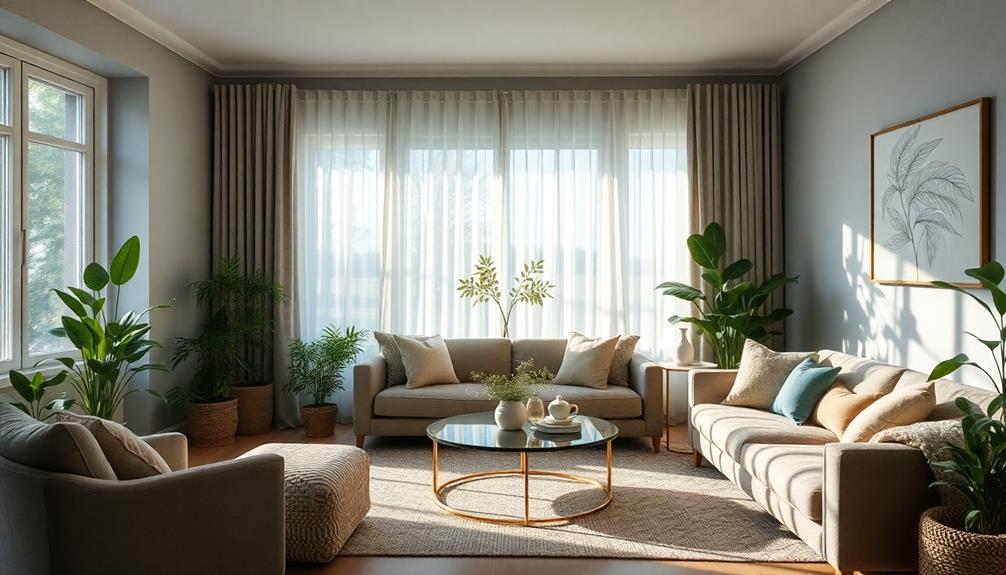
Incorporating balanced color combinations into your interiors creates a harmonious environment that fosters well-being. By utilizing the five elements of feng shui—earth, metal, water, wood, and fire—you can promote harmonious energy flows in your home. For instance, pairing warm earth tones with cool blues or greens enhances tranquility while stimulating creativity.
You can also mix neutral colors like beige or gray with vibrant accents such as red or orange to maintain visual interest without overwhelming the senses. Color theory can guide you in selecting the best colors that evoke desired emotional responses, whether calming or energizing.
Here's a visual representation of some effective balanced color combinations:
| Element | Color Combination |
|---|---|
| Earth Element | Warm earth tones + Cool blues |
| Water Energy | Soft blues + Green accents |
| Fire Energy | Neutrals + Vibrant red/orange |
Thoughtful layering of colors creates depth and harmony, with lighter shades reflecting light and darker hues adding richness. This layering fosters a nurturing atmosphere, ensuring that the energy in your home feels balanced and inviting.
Frequently Asked Questions
What Colors Should Be Avoided in Feng Shui?
You should avoid excessive black, overly bright colors, too much red, and dark shades in small spaces. Also, steer clear of an abundance of white, as it can feel sterile and lifeless in your environment.
Which Colour Is Lucky for House Interior?
Imagine a vibrant sunset filling your home with warmth. For luck in your interiors, embrace red's passion, yellow's cheer, or green's healing touch. Each color invites prosperity, nurturing, and growth, transforming your space into a sanctuary.
What Is the Best Color to Paint in Feng Shui?
To choose the best color in Feng Shui, consider each room's purpose. Serene blues for bedrooms, vibrant reds for living spaces, and soft hues for bathrooms can all enhance energy and create harmony in your home.
What Is the Power Color in Feng Shui?
Imagine your home office glowing with red accents; it energizes creativity and attracts prosperity. In Feng Shui, red's your power color, symbolizing luck and wealth, but balance it with softer hues to maintain harmony.
Conclusion
By now, you've probably noticed how colors impact your mood and energy levels in your space. Isn't it fascinating how a splash of warm hues can energize your mornings, while cool tones create a serene evening retreat? Just imagine blending those balanced combinations for ultimate harmony. As you experiment with these feng shui color schemes, you might stumble upon a perfect palette that transforms your home into a sanctuary, making every moment feel just right.
- About the Author
- Latest Posts
Introducing Ron, the home decor aficionado at ByRetreat, whose passion for creating beautiful and inviting spaces is at the heart of his work. With his deep knowledge of home decor and his innate sense of style, Ron brings a wealth of expertise and a keen eye for detail to the ByRetreat team.
Ron’s love for home decor goes beyond aesthetics; he understands that our surroundings play a significant role in our overall well-being and productivity. With this in mind, Ron is dedicated to transforming remote workspaces into havens of comfort, functionality, and beauty.
-

 Retreat3 weeks ago
Retreat3 weeks agoDIY Aromatherapy Diffusers for a Spa-Like Atmosphere at Home
-

 Retreat4 weeks ago
Retreat4 weeks agoThe Profitability of Retreat Centers: A Financial Analysis
-

 Retreat2 weeks ago
Retreat2 weeks agoThe Business of Retreats: Marketing Strategies for Success
-
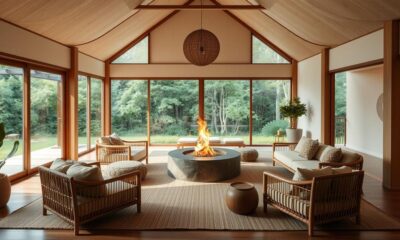
 Retreat2 weeks ago
Retreat2 weeks ago10 Unique Themed Room Ideas for Your Retreat Center
-

 Southeast Asia Decor2 weeks ago
Southeast Asia Decor2 weeks agoIndonesian Textiles Shaping Contemporary Interior Design
-

 Retreat3 weeks ago
Retreat3 weeks agoThe Psychology of Color in Retreat Center Design
-

 Retreat4 weeks ago
Retreat4 weeks agoUnusual DIY Projects: Designing a Space Probe in Bitlife
-

 Retreat3 weeks ago
Retreat3 weeks agoHow to Create a Zen Garden for Your Retreat Center











